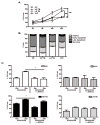Restimulation-induced T-cell death through NTB-A/SAP signaling pathway is impaired in tuberculosis patients with depressed immune responses
- PMID: 28546549
- PMCID: PMC5595630
- DOI: 10.1038/icb.2017.42
Restimulation-induced T-cell death through NTB-A/SAP signaling pathway is impaired in tuberculosis patients with depressed immune responses
Abstract
Production of IFN-γ contributes to host defense against Mycobacterium tuberculosis (Mtb) infection. We previously demonstrated that Signaling lymphocytic activation molecule-associated protein (SAP) expression on cells from tuberculosis (TB) patients was inversely correlated with IFN-γ production. Here we first investigated the role of NK, T- and B-cell antigen (NTB-A)/SAP pathway in the regulation of Th1 response against Mtb. Upon antigen stimulation, NTB-A phosphorylation rapidly increases and afterwards modulates IFN-γ and IL-17 secretion. To sustain a healthy immune system, controlled expansion and contraction of lymphocytes, both during and after an adaptive immune response, is essential. Besides, restimulation-induced cell death (RICD) results in an essential homeostatic mechanism for precluding excess T-cell accumulation and associated immunopathology during the course of certain infections. Accordingly, we found that the NTB-A/SAP pathway was required for RICD during active tuberculosis. In low responder (LR) TB patients, impaired RICD was associated with diminished FASL levels, IL-2 production and CD25high expression after cell-restimulation. Interestingly, we next observed that SAP mediated the recruitment of the Src-related kinase FYNT, only in T cells from LR TB patients that were resistant to RICD. Together, we showed that the NTB-A/SAP pathway regulates T-cell activation and RICD during human TB. Moreover, the NTB-A/SAP/FYNT axis promotes polarization to an unfavorable Th2-phenotype.
Conflict of interest statement
The authors declare no conflict of interest.
Figures






Similar articles
-
SAP facilitates recruitment and activation of LCK at NTB-A receptors during restimulation-induced cell death.J Immunol. 2014 May 1;192(9):4202-9. doi: 10.4049/jimmunol.1303070. Epub 2014 Mar 31. J Immunol. 2014. PMID: 24688028
-
Restimulation-induced apoptosis of T cells is impaired in patients with X-linked lymphoproliferative disease caused by SAP deficiency.J Clin Invest. 2009 Oct;119(10):2976-89. doi: 10.1172/JCI39518. Epub 2009 Sep 14. J Clin Invest. 2009. PMID: 19759517 Free PMC article.
-
Expression of signaling lymphocytic activation molecule-associated protein interrupts IFN-gamma production in human tuberculosis.J Immunol. 2004 Jan 15;172(2):1177-85. doi: 10.4049/jimmunol.172.2.1177. J Immunol. 2004. PMID: 14707094
-
NK cell regulation by SLAM family receptors and SAP-related adapters.Immunol Rev. 2006 Dec;214:22-34. doi: 10.1111/j.1600-065X.2006.00453.x. Immunol Rev. 2006. PMID: 17100873 Review.
-
[Protective immunity against Mycobacterium tuberculosis].Kekkaku. 2006 Nov;81(11):687-91. Kekkaku. 2006. PMID: 17154048 Review. Japanese.
Cited by
-
SLAMF receptors: key regulators of tumor progression and emerging targets for cancer immunotherapy.Mol Cancer. 2025 May 17;24(1):145. doi: 10.1186/s12943-025-02308-8. Mol Cancer. 2025. PMID: 40382610 Free PMC article. Review.
-
Molecular and temporal control of restimulation-induced cell death (RICD) in T lymphocytes.Front Cell Death. 2023;2:1281137. doi: 10.3389/fceld.2023.1281137. Epub 2023 Oct 30. Front Cell Death. 2023. PMID: 38074985 Free PMC article.
-
The Non-synonymous rs763780 Single-Nucleotide Polymorphism in IL17F Gene Is Associated With Susceptibility to Tuberculosis and Advanced Disease Severity in Argentina.Front Immunol. 2019 Sep 20;10:2248. doi: 10.3389/fimmu.2019.02248. eCollection 2019. Front Immunol. 2019. PMID: 31616423 Free PMC article.
-
FOXP3 renders activated human regulatory T cells resistant to restimulation-induced cell death by suppressing SAP expression.Cell Immunol. 2018 May;327:54-61. doi: 10.1016/j.cellimm.2018.02.007. Epub 2018 Feb 12. Cell Immunol. 2018. PMID: 29454648 Free PMC article.
-
SLAM Associated Protein Signaling in T Cells: Tilting the Balance Toward Autoimmunity.Front Immunol. 2021 Apr 16;12:654839. doi: 10.3389/fimmu.2021.654839. eCollection 2021. Front Immunol. 2021. PMID: 33936082 Free PMC article. Review.
References
-
- World Health Organization (WHO) Global tuberculosis report 2014. WHO Library; Geneva S:
-
- Sodhi A, Gong J, Silva C, Qian D, Barnes PF. Clinical correlates of interferon gamma production in patients with tuberculosis. Clinical infectious diseases : an official publication of the Infectious Diseases Society of America. 1997;25(3):617–20. - PubMed
-
- Dorman SE, Holland SM. Interferon-gamma and interleukin-12 pathway defects and human disease. Cytokine & growth factor reviews. 2000;11(4):321–33. - PubMed
-
- Saito T. Negative regulation of T cell activation. Current opinion in immunology. 1998;10(3):313–21. - PubMed
MeSH terms
Substances
Grants and funding
LinkOut - more resources
Full Text Sources
Other Literature Sources
Medical
Miscellaneous

